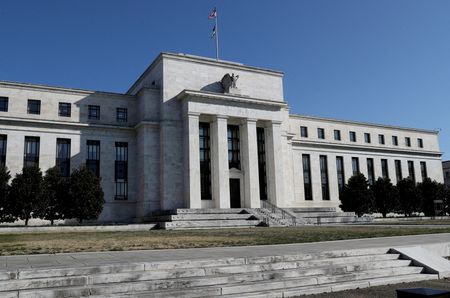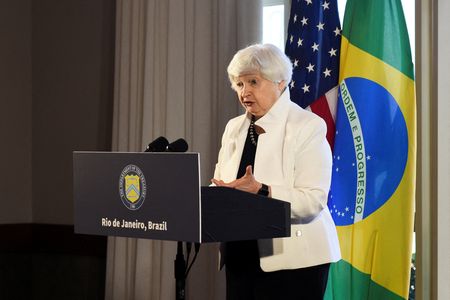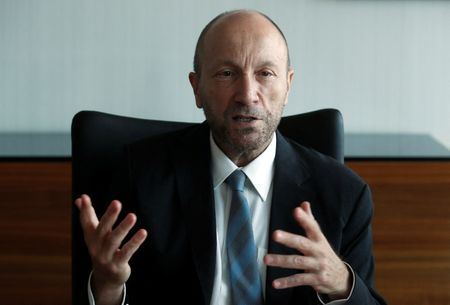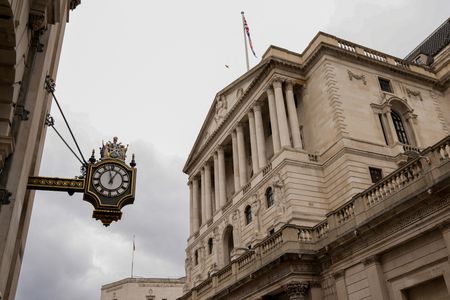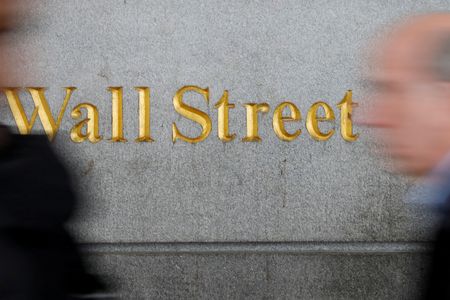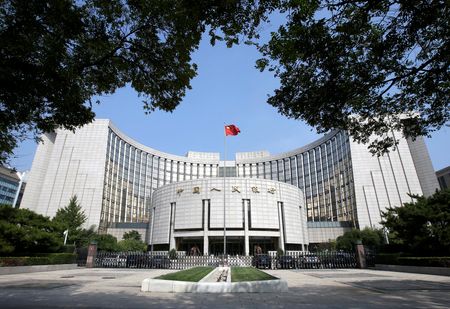LONDON (Reuters) -U.S. Federal Reserve and Bank of Japan meetings, a G7 gathering, plus key U.S. inflation and UK jobs data are all coming up in the week ahead – and that’s not all.
Markets are digesting results from the June 6-9 European Parliament election and a shock decision from France to hold a snap election, while Britain’s Labour Party is expected to unveil its policy plans before a July 4 election it is tipped to win.
Here’s the lowdown on the week ahead in world markets from Lewis Krauskopf and Ira Iosebashvili in New York, Kevin Buckland in Tokyo, and Karin Strohecker, Dhara Ranasinghe and David Milliken in London:
1/ DOUBLE TROUBLE
The Fed looks certain to hold rates steady when it ends a two-day meeting on June 12.
Inflation has cooled after aggressive rate hikes starting in 2022 but has not yet fallen to its 2% target.
May inflation figures are released just hours before the Fed statement. Further signs of inflation easing could cement expectations for rate cuts, especially given signs of economic weakness.
Wall Street, boosted by cooling inflation, will be watching closely. Traders continue to price in some monetary easing this year, although bets for a September move were slashed after Friday’s robust jobs numbers.
A bad inflation miss could spook investors and bring back recession fears that have laid dormant for months.
No doubt, the data could fire markets up ahead of Fed Chair Jerome Powell’s post-meeting press conference.
2/ TALE OF THE TAPER
Bank of Japan Governor Kazuo Ueda has already dropped a strong hint of what to expect at June’s meeting.
He said on Thursday that it would be appropriate to reduce still-massive bond purchases as the BOJ exits decades of stimulus, stressing policymakers will move “cautiously” on rate hikes after delivering its first rise since 2007 in March.
A consensus is building for some kind of taper of long-running quantitative easing when the BOJ concludes its two-day gathering on June 14.
Mizuho Securities sees a good chance of a 1 trillion yen ($6.4 billion) cut in monthly purchases to roughly 5 trillion yen per month, which could be weathered by bond markets.
Whether that supports the battered yen is a separate matter, with the BOJ and government concerned a weak currency could derail a hoped-for cycle of mild inflation and steady wage gains.
3/ PUSHING FOR UKRAINE
Leaders of the Group of Seven are pushing for progress on how to funnel urgently needed funds to Ukraine at a June 13-15 meeting in Bari, Italy, before they head to Switzerland for the peace summit on June 15-16. The push follows a recent EU decision to use the annual flow of windfall profits earned on immobilized Russian assets.
A loan backed by the income from frozen assets could provide Kyiv with as much as $50 billion in near-term funding and has emerged as one top option.
Concerns by G7 policymakers over China’s growing export strength, dubbed “industrial overcapacity”, particularly regarding new energy vehicles, is also in focus.
The G7 meets just after EU elections and key EU figures get the chance to discuss the outcome as well as the fallout from French President Emmanuel Macron’s decision to call a snap election after being trounced in the EU vote by the far right.
4/ PAY DAY
Labour market data on Tuesday is in focus for UK investors assessing whether wage pressures are easing fast enough to make a Bank of England rate cut a near-term prospect.
Average weekly earnings, excluding bonuses, rose by an annual 6% in the three months to March, and April’s 9.8% increase to Britain’s minimum wage may push that growth rate higher.
Until recently, economists expected a June rate cut but persistent inflation pressures mean markets do not fully price in a move until November.
Wednesday’s April GDP data is likely to show growth softened after a robust 0.6% expansion in Q1. S&P says PMI data points to 0.3% growth for Q2 overall.
And the opposition Labour Party launches its manifesto ahead of the July 4 election. While polls suggest Labour will hammer Prime Minister Rishi Sunak’s Conservatives, some business leaders doubt Labour can turn around Britain’s recent weak growth performance.
5/ THE TAYLOR RULE
It’s Europe’s turn to benefit from music superstar Taylor Swift’s Eras Tour, hitting Britain, then the Netherlands and Switzerland.
Barclays reckons the tour could provide an almost one billion pound boost to Britain’s economy, with spending by ticket holders more than 12 times the average cost of a UK night out.
The Bank of America Institute says the tour’s opening leg in Paris sparked a 22% year-on-year jump in international BofA card spending in the French capital May 9-13.
The spending boost, even if temporary, suggests service-sector inflation could remain sticky for longer. Some reckon the real winner is Swift: the Eras tour made her a billionaire in October, Time magazine reported. And this won’t be the last time economists debate “Swiftflation” and “Swiftonomics”.
(Compiled by Dhara Ranasinghe; Graphics by Prinz Magtulis, Pasit Kongkunakornkul, Sumanta Sen and Vineet Sachdev; Editing by Christina Fincher and Bernadette Baum)

